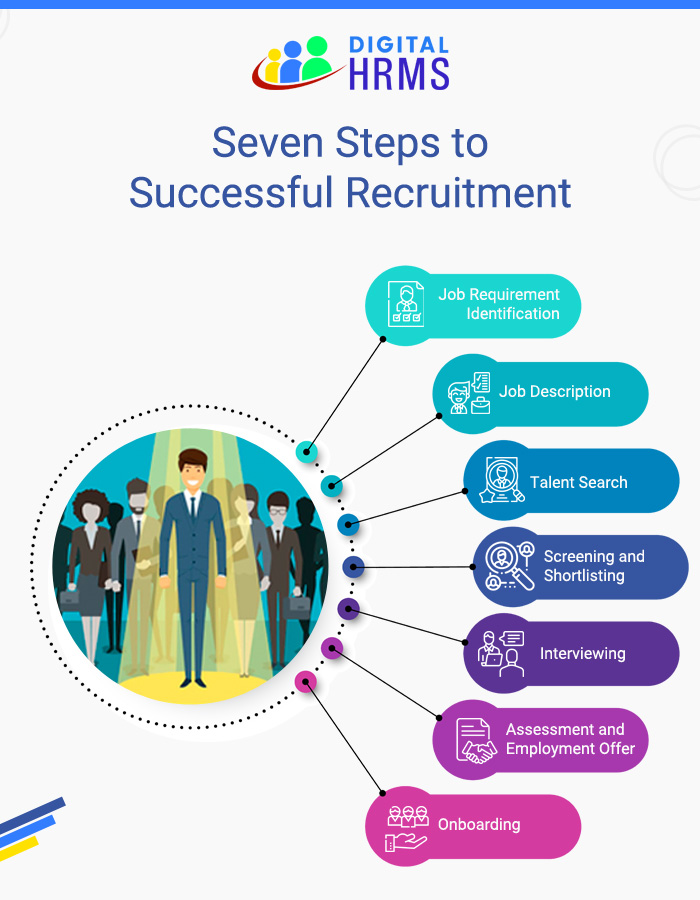Key Strategies to be Followed in the Recruitment Process in Order to Acquire the Best Talents in the Market

What would be your largest recruitment stumbling block if you had to choose one? Your responses may differ based on the size of the organization you work for or the kind of positions you're filling. Most recruiters, on the other hand, would focus on a few typical recruitment issues which should be resolved if a proper recruitment process is employed.
Seven Steps to Successful Recruitment
In order to the Recruitment process being successful, it should consist of 7 important steps

1. Job Requirement Identification
You won't be able to find what you need if you don't know what you need in the first place, whether a job opportunity is freshly founded or recently resigned. As a result, your hiring process should begin with finding open positions and then reviewing job descriptions, including the knowledge, abilities, and experience required for the position.
2. Job Description
It's time to figure out the job's duties and responsibilities after you know exactly what you need in terms of education, abilities, and experience. Preparing a detailed job description (JD) can assist you in determining what qualifications your potential workers must possess in order to satisfy the role's requirements. More crucially, it gives a checklist or a list to which your prospects may compare themselves before applying. It's a tool for making sure you get applications from the appropriate candidates.
3. Talent Search
The most critical components of the recruiting process are identifying the appropriate talent, enticing them, and encouraging them to apply. Internally, to create referrals, as well as externally, on prominent social networking sites and favoured job boards, the job listing should be posted. To reach a larger audience, recruiters might hold job fairs and advertise job opportunities in key industry journals. In general, there are two types of recruitment sources available for a talent search: Whether internal or external.
4. Screening and Shortlisting
You must screen and select applicants swiftly and precisely in order to go on with the recruiting process. This is when the hiring process becomes challenging and tough. The process of screening candidates' applications in preparation for the next stage of the selection process is known as screening. Here there are four steps -
- First, we go through the applications to determine those that meet the minimum requirements.
- Then we separate resumes based on desirable qualifications. We look at the applicant's work history, certificates, domain and technical competence, and skills in this section.
- Candidates with the bare minimum of qualifications and credentials will be shortlisted.
- We'd make a note of any issues we had about their application so we could address them at the interview.
5. Interviewing
Prior to getting an offer letter or a rejection notice, the selected applicants will go through the interview procedure. Several interviews may be planned for each candidate, depending on the size of the recruiting team and their particular recruitment needs. Steps involved are -
- Shortlist through telephone interview
- Face-to-face interviews
- HR Interviews
- Reference checks
6. Assessment and Employment Offer
It's time to determine who you want to recruit once you've interviewed the shortlisted applicants and reviewed their references. When making the job offer, it's critical to set a start date and agree on the terms. Salary, scheduling, and background check are among them. It's a good idea to keep the other prospects on the table until the preferred candidate accepts the job offer.
The hiring and onboarding of your new employee is the final step in the process. The new employee is ready to begin the onboarding process after accepting the job offer. This entails giving them with the required training, coaching, and resources to help them effectively integrate into the firm or organisation. Because you want new recruits to feel comfortable and welcome at their new work, it's critical that the induction program that makes up this last step is good. This reduces employee turnover and helps to build or preserve the company's reputation.
The Digital HRMS contains a comprehensive Recruitment module that includes all the above aspects of the recruitment process, including defining the requirement, finding candidates, arranging interviews, initiating hiring, and releasing the offer. The automated resume parsing platform provided by the Digital HRMS recruitment management system, delivers a comprehensive range of tools to assist your recruiting teams in extracting the most important data from hundreds of resumes in a single operation.
Visit www.digitalhrms.com or send an email to marketing@digitalhrms.com, and a member of our team will contact you.